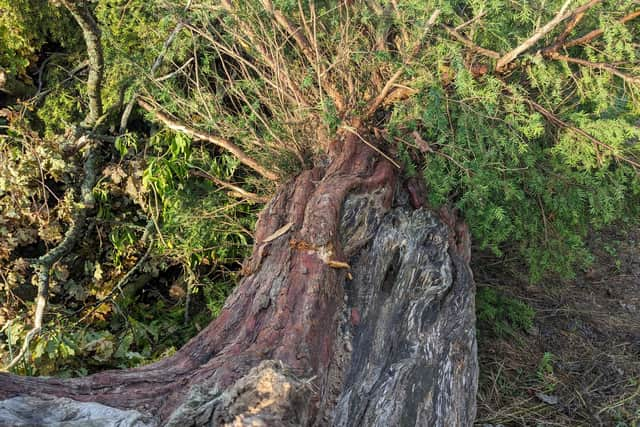Dismay over loss of 1,000-year-old yew tree at Battle which pre-dates the Battle of Hastings


People have been saddened after an ancient yew tree was discovered on its side in a field.
The tree was in a privately owned field near Uckham Lane, Battle, a mile from Senlac Hill, the site of the Battle of Hastings.
Advertisement
Hide AdAdvertisement
Hide AdThe situation has caused anger locally with some people alleging the tree was removed.
But there is no evidence to suggest this and others believe the tree, which was in full leaf, may have been toppled by recent strong winds.


One person suggested that the roots of the tree were showing rot, which would have made it unstable. It is estimated that the tree would have been 40ft high when standing.
Stephen White said: “The tree is important as an ancient monument and part of Battle's history and heritage.”
Advertisement
Hide AdAdvertisement
Hide AdSpeaking to the Argus in Brighton, Paul Lawrence, 51, said: “I first saw it on the ground when walking the dog. The tree means a lot to me, my grandad’s ashes were sprinkled there. I have a personal connection to the tree.”
Many trees of that age are protected by Tree Preservation Orders, which are made by a local planning authority to protect specific trees, groups of trees or woodlands. If an order is in place it prohibits cutting down, felling or causing wilful damage to the tree. Not all old trees are covered by Preservation Orders though as these need to be sought. Rother District Council said it cannot comment as the tree was on private land.


The yew tree was just a few miles away from the famous Crowhurst Yew, which stand in St George’s churchyard. That tree is estimated to be at least 1,300 years old.
The discovery of the tree coincides with national outrage at the felling of the Sycamore Gap tree near Hadrian’s Wall in Northumberland, last week.
Advertisement
Hide AdAdvertisement
Hide AdThe yew is one of the longest-lived native species in Europe and is steeped in folklore. Yew trees are associated with churchyards and there are at least 500 churchyards in England which contain yew trees older than the buildings themselves. It is not clear why, but it is thought that yew trees were planted on the graves of plague victims to protect and purify the dead, and also in churchyards to stop 'commoners' from grazing their cattle on church ground as yew is extremely poisonous to livestock.Yew trees were used as symbols of immortality, but also seen as omens of doom. For many centuries it was the custom for yew branches to be carried on Palm Sunday and at funerals.
Have you read? Amazing picture of a seal catching a large fish off Hastings